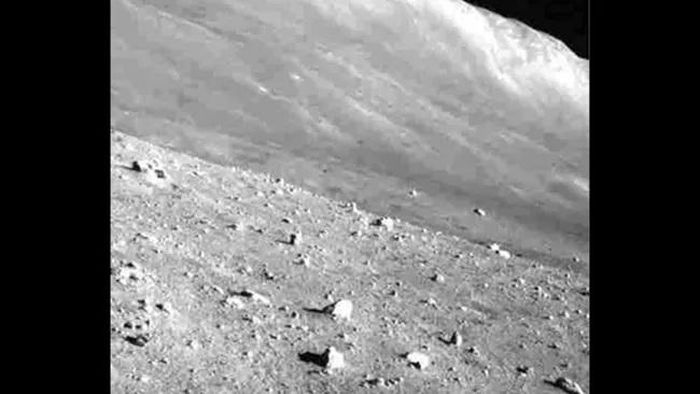Japan's lander survives second night on the moon

SLIM is not dead yet
The SLIM spacecraft, Japan's first successful lunar lander, has survived the long, cold night on the moon for the second time. Mission team members announced the news via X in late March, in a post with a new photo taken by the lander's navigation camera.
SLIM, the abbreviation for "Smart Lander for Lunar Investigation", launched last September and landed on the moon on January 19, making Japan the fifth country in the real world perform a soft landing on the moon. The four countries that have successfully landed on the moon are the former Soviet Union, the United States, China and India.
The solar-powered SLIM landed on the moon, a less than optimal direction for capturing sunlight. The 200 kg probe went dark shortly afterwards but then woke up on January 28 and began collecting data.
The mission team put SLIM into hibernation for a few days and two weeks later, while the surface temperature at the lunar site dropped to about minus 130 degrees Celsius.
SLIM had already achieved its main mission goals – making a precision lunar landing, deploying two small rovers and doing much of the science work – at that time and was not expected to last. anymore.
Yet, SLIM is now having its second revival, although the harsh conditions are starting to take a toll on this lucky little robot.
"According to the data obtained, some temperature sensors and unused batteries are starting to malfunction, but the majority of functions that survived the first moon night are maintained even after the second moon night ,' the information team members said in a post on social network X.
Meanwhile, the January collapse of SLIM was followed by the US ship Odysseus. Odysseus' moon landing was the first by a private spacecraft and the first by an American vehicle since Apollo 17 in 1972.
Odysseus was active for a week on the moon's surface, then fell silent before the first moonlit night. And this silence is forever. Intuitive Machines announced earlier this week that Odysseus's quest was over.
You should read it
- MSI X-Slim X600 saves power
- MSI adds rivals for MacBook Air
- MSI X-Slim X430 Laptop: The hidden bar contains power
- MSI continues to upgrade the X-Slim series
- MSI X-Slim - super power saving
- MSI Slim X400 - rival of the Mac Air
- Review of Lenovo YOGA Slim 9i laptop
- Should I upgrade to the new PS5 Slim? Here is the answer
May be interested
- One day on the Moon is equal to how many days on Earth?
 the time it takes for the moon to orbit the earth is about 27.3 days, while the earth rotates once around its axis in 24 hours (one day - one night).
the time it takes for the moon to orbit the earth is about 27.3 days, while the earth rotates once around its axis in 24 hours (one day - one night). - Full Moon facts - Full moon you may not know yet
 full moon sign (full moon) once in each month is a time when we can clearly see things around. in culture and history, the full moon has another meaning, which is the change from month to month for a year. here are the mysteries of full moon - full moon may not be known.
full moon sign (full moon) once in each month is a time when we can clearly see things around. in culture and history, the full moon has another meaning, which is the change from month to month for a year. here are the mysteries of full moon - full moon may not be known. - Admire the beautiful super moon image in the sky of Vietnam and the world
 let's review a round to admire the image of interesting astronomical phenomena, super moon takes place around the earth last night, 3/12.
let's review a round to admire the image of interesting astronomical phenomena, super moon takes place around the earth last night, 3/12. - This is why we always see the Moon always following us
 if you look a little bit, you will realize that even when walking or driving, the moon and the stars always follow you, while the roadside objects like trees and buildings will gradually retreat to the side. after. why so?
if you look a little bit, you will realize that even when walking or driving, the moon and the stars always follow you, while the roadside objects like trees and buildings will gradually retreat to the side. after. why so? - Synthesize high resolution moon wallpaper on computer
 summarize the moon wallpaper set with multiple resolutions for computers and laptops
summarize the moon wallpaper set with multiple resolutions for computers and laptops - We may be able to see the 'second moon' in the sky with the naked eye next May
 this second moon is actually a comet called atlas (original name is c / 2019 y4) will have the same brightness as our moon and is heading towards earth but not crashing.
this second moon is actually a comet called atlas (original name is c / 2019 y4) will have the same brightness as our moon and is heading towards earth but not crashing. - Unexpected discoveries of the full moon
 this phenomenon is always associated with mystical stories that make scientists headaches.
this phenomenon is always associated with mystical stories that make scientists headaches. - Why didn't NASA intend to return to the Moon?
 in 1969, nasa made history when it completed the mission to set foot on the moon. since then, conquering the moon has become the ambition of many countries around the world. but why has nearly 50 years passed without nasa planning to return to the moon?
in 1969, nasa made history when it completed the mission to set foot on the moon. since then, conquering the moon has become the ambition of many countries around the world. but why has nearly 50 years passed without nasa planning to return to the moon? - New technology helps NASA find water, self-sufficient food on the moon
 nasa is stepping up the preparation of technologies necessary both in terms of vehicles, people and logistics to serve the purpose of ambitious moon recovery.
nasa is stepping up the preparation of technologies necessary both in terms of vehicles, people and logistics to serve the purpose of ambitious moon recovery. - The biggest super moon in 70 years will appear on November 14
 let's observe the 21st century super moon on november 14, 2016!
let's observe the 21st century super moon on november 14, 2016!










 One in every 13 bridges in the US is deteriorating
One in every 13 bridges in the US is deteriorating April Fools' Day originated from which country?
April Fools' Day originated from which country? The tunnel transports people with magnets at up to 1,000km/h
The tunnel transports people with magnets at up to 1,000km/h The times the US lost nuclear bombs, they have never been found
The times the US lost nuclear bombs, they have never been found Humans transmit more viruses to animals than they transmit to humans
Humans transmit more viruses to animals than they transmit to humans 21 species of plants and flowers are beautiful but contain deadly poison
21 species of plants and flowers are beautiful but contain deadly poison